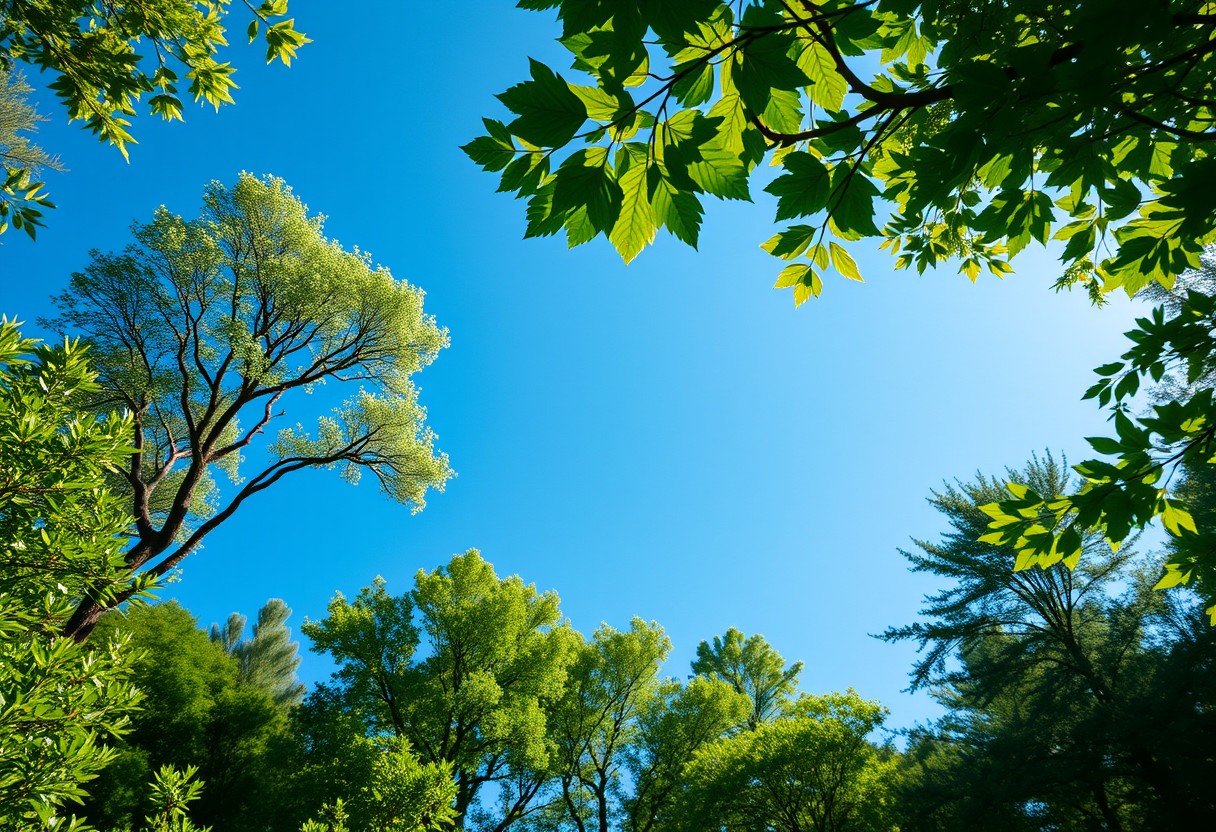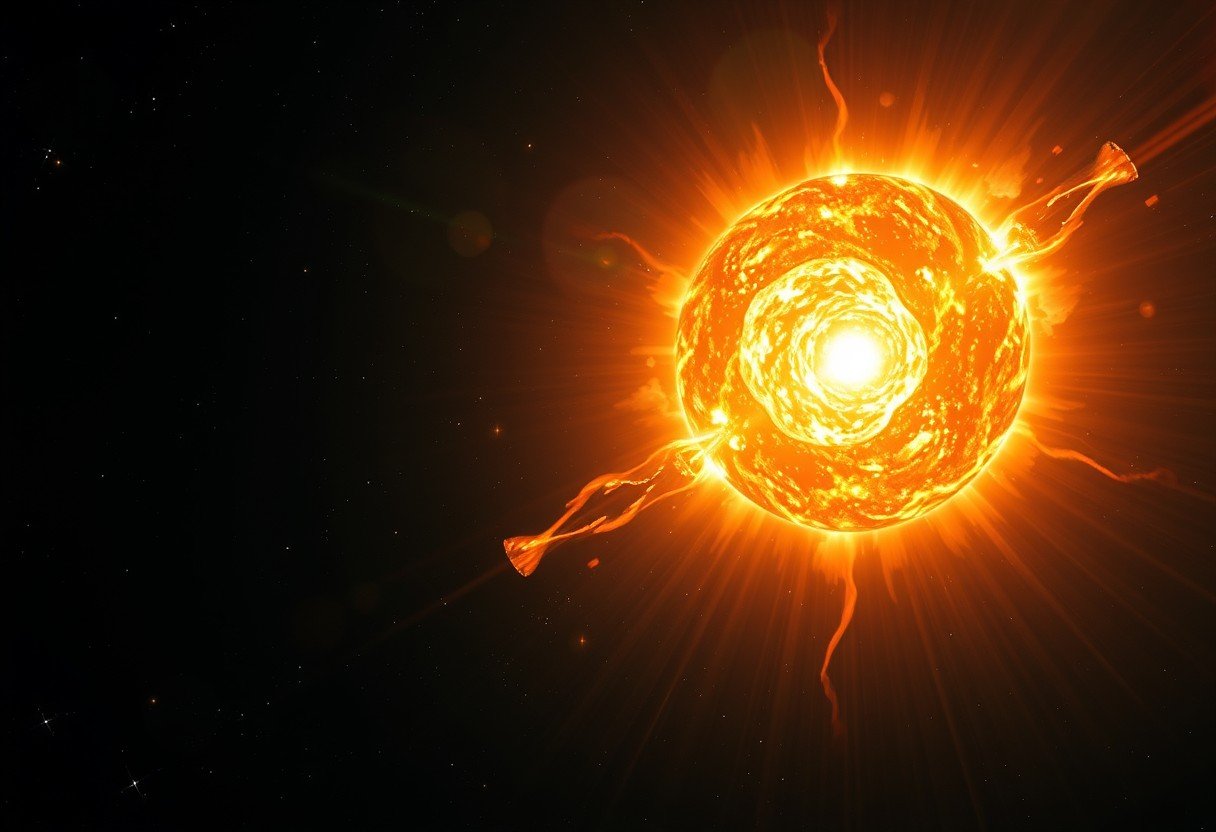Oxygen in the air exists because plants, algae and cyanobacteria began making it on Earth billions of years ago. They use sunlight to split water and fix carbon dioxide, and the extra oxygen escapes to the sky. This explains what produces our breathable air, where it happens on land and sea, who does it, how it works and why it matters for life and climate today.
What Part of the Air Comes from Photosynthesis
Earth’s free oxygen gas, the O2 you breathe, is a product of oxygenic photosynthesis. Before this biology evolved, the atmosphere held almost no O2. Rock records and models show that oxygen rose in steps, then stabilized near today’s level.
About 21 percent of the atmosphere is oxygen, and nearly all of it was built by photosynthetic life over geologic time.
Scientists see this change in banded iron formations and sulfur isotope signals that appear when oxygen became common. These markers tell the story of how life reshaped the air above us.
How Photosynthesis Makes Oxygen
Inside leaves and algal cells, pigments capture light. That energy drives reactions that split water into electrons, protons and oxygen, then builds sugars from carbon dioxide. The oxygen is released as a gas.
- Light hits chlorophyll and powers the light reactions.
- Water is split, producing O2 and energy carriers ATP and NADPH.
- The Calvin cycle uses CO2 with ATP and NADPH to make sugars.
- O2 diffuses out through leaf stomata or from plankton into water and air.
In short, water is the source of the oxygen in O2, and sunlight is the engine that frees it.
This pathway is measured in labs and in the field using gas exchange and fluorescence tools, confirming how cells turn light into chemical energy and oxygen.
The Carbon Cycle Link and Greenhouse Balance
Photosynthesis pulls CO2 from air and stores carbon in plants, plankton, soils and the ocean. Respiration, fires and decay return much of that CO2, closing the loop. Over land and sea combined, gross primary production is about 120 petagrams of carbon per year, with roughly half stored short term as net primary production.
By lowering CO2 while creating O2, photosynthesis supports climate balance and makes high energy aerobic life possible.
Long term, a small fraction of organic carbon gets buried in sediments. That burial is what lets O2 build up over millions of years. Without burial, respiration would use up the extra oxygen and keep levels low.
What Is in Earth’s Air Today
Dry air is mostly nitrogen and oxygen, with small amounts of argon and trace gases. Water vapor varies by location and weather. Values below are typical global means for dry air compiled by research groups such as NASA and NOAA.
| Gas | Approximate Share of Dry Air | Notes |
|---|---|---|
| Nitrogen (N2) | 78.08% | Biologically important but not from photosynthesis |
| Oxygen (O2) | 20.95% | Produced by oxygenic photosynthesis over time |
| Argon (Ar) | 0.93% | Inert gas from Earth’s interior |
| Carbon dioxide (CO2) | 0.042% | About 422 parts per million in 2024, rising |
| Neon (Ne) | 0.0018% | Trace noble gas |
| Helium (He) | 0.00052% | Trace noble gas |
| Methane (CH4) | 0.00019% | About 1.9 to 2.0 parts per million in 2024 |
| Krypton (Kr) | 0.00011% | Trace noble gas |
| Hydrogen (H2) | 0.000055% | Very low but climatically active in chemistry |
Water vapor ranges from near zero in cold dry air to several percent in warm humid air and is not part of dry air totals.
Oceans, Forests and the Share of Oxygen Production
Phytoplankton in the ocean and plants on land each make large shares of global oxygen. Many studies estimate that ocean plankton account for about half of present day photosynthesis, with the rest mainly from forests, grasslands and crops.
Over short times, both sea and land add O2 to the air, but most of that oxygen is used back up by respiration, so the long term rise depends on carbon burial.
Field measurements, satellite data and oxygen isotopes support this split. The message is simple. Protecting both healthy seas and healthy forests keeps the system stable.
The Great Oxygenation Event and Life’s Rise
Between about 2.4 and 2.0 billion years ago, cyanobacteria released enough oxygen to change ocean and air chemistry. Iron in seawater rusted and fell to the seafloor, leaving layered rocks that record the change. Many anaerobic microbes declined as oxygen spread.
Later oxygen increases between 800 and 400 million years ago supported bigger bodies, complex food webs and animals that need a lot of energy.
Geologists see these steps in sulfur and molybdenum records, fossil steroids from early eukaryotes and shifts in weathering products on land. These clues tie the air’s oxygen to the evolution of complex life.
Human Pressures and How to Help Keep Oxygen Flowing
Global oxygen percent remains very stable, though instruments detect a tiny yearly decline linked to fossil fuel burning and CO2 rise. Local oxygen stress is a real risk in lakes, rivers and coastal waters when excess nutrients trigger dead zones. Forest loss and warming can also cut photosynthesis in some regions.
Keeping oxygen steady means safeguarding the producers and the places where they live, from rainforests to the open ocean.
- Protect and restore forests, mangroves and seagrass that drive high photosynthesis.
- Cut nutrient runoff that fuels low oxygen dead zones on coasts.
- Reduce fossil fuel use and grow clean energy to lower CO2 and heat stress on ecosystems.
Long running records from NOAA and partner labs track O2 and CO2 together, confirming these small global trends and the value of smart land and water care.
FAQ
Is the oxygen in our air entirely from photosynthesis?
Yes. Free O2 is made when photosynthetic organisms split water and release oxygen as a gas. Geological oxygen from reactions is tiny compared with the biological source.
How long would oxygen last if photosynthesis stopped today?
Scientists estimate the atmosphere would lose breathable oxygen over thousands of years as fires, rusting and respiration use it up. The exact pace depends on land cover, ocean biology and climate.
Do volcanoes or sunlight make a meaningful amount of oxygen?
Volcanoes do not add free O2, and sunlight can split some molecules high in the sky but the amounts are very small. Photosynthesis is the only process that makes large, lasting O2.
Which organisms produce the most oxygen right now?
Phytoplankton at sea and plants on land each contribute roughly half of global photosynthesis. The split shifts with seasons, climate and nutrient supply.
Does cutting rainforests reduce global oxygen right away?
It harms biodiversity and carbon storage at once, but the global O2 percent changes only slightly because the atmosphere is huge. Still, forest loss lowers long term oxygen stability by reducing carbon burial and raising CO2.
What percent of air is oxygen and has it changed over time?
Oxygen is about 20.95 percent of dry air today. Deep time records show it was near zero early in Earth history, rose in steps after 2.4 billion years ago and has varied within a few percent during the last hundreds of millions of years.









Leave a Comment